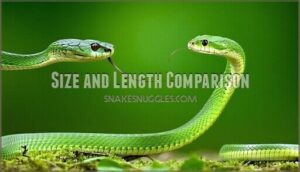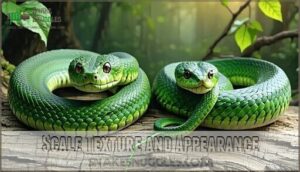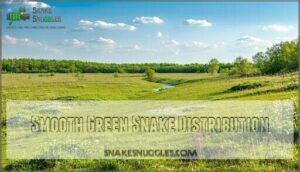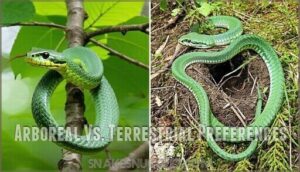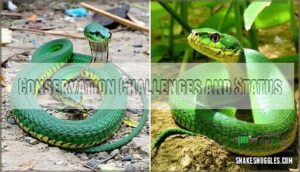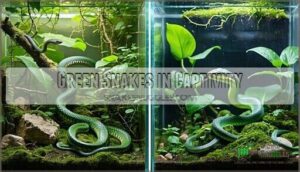This site is supported by our readers. We may earn a commission, at no cost to you, if you purchase through links.
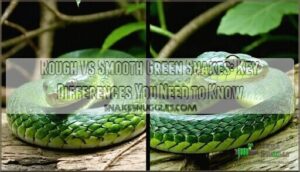
Rough green snakes usually grow larger at 14-33 inches compared to smooth green snakes’ 11-26 inches, and they prefer climbing through southeastern vegetation near water sources rather than staying ground-level like their smooth cousins in northeastern regions.
Both species maintain vibrant green camouflage and hunt insects during daylight hours, but scale texture remains your most reliable identification method.
Table Of Contents
- Key Takeaways
- Key Physical Differences Between Green Snakes
- Habitat and Geographic Range
- Behavior and Ecology
- Conservation Challenges and Status
- Green Snakes in Captivity
- Frequently Asked Questions (FAQs)
- How can I tell the two species apart in the wild?
- Are there any differences in the lifespan of these two species?
- Are there any notable behavioral differences between the two snake species?
- How long do green snakes live?
- When do green snakes mate and reproduce?
- Are green snakes venomous or dangerous?
- What predators hunt green snakes?
- Can you legally own green snakes?
- Conclusion
Key Takeaways
- You’ll identify these snakes by feeling their scales – rough green snakes have keeled scales that feel like sandpaper, while smooth green snakes have flat, glossy scales that slip through your fingers.
- You can distinguish them by size since rough green snakes grow larger at 14-33 inches compared to smooth green snakes’ 11-26 inches in length.
- You’ll find them in different habitats – rough green snakes climb trees and shrubs in southeastern regions near water, while smooth green snakes stay on the ground in northeastern areas.
- You’ll notice they’re both non-venomous, eat insects during the day, and share the same bright green camouflage coloring despite their physical differences.
Key Physical Differences Between Green Snakes
If you’re trying to tell rough and smooth green snakes apart, you’ll need to look closely at their physical features since both species share that vibrant emerald coloration. The most reliable way to distinguish these closely related North American colubrids is by examining their scale texture, body size, and eye proportions.
Size and Length Comparison
When comparing these North American colubrids, you’ll notice striking Length Variations between species. Rough Green Snakes (Opheodrys aestivus) usually reach 14-33 inches, while Smooth Green Snakes (Opheodrys vernalis) average just 11-26 inches.
Key Size Factors include:
- Maximum lengths: rough specimens can exceed 40 inches
- Body Proportions: both maintain slender builds under 1-inch diameter
- Growth Rates: rough species mature slower, reaching larger adult sizes
Understanding the green snake differences is essential for identifying these species.
Scale Texture and Appearance
The most obvious difference you’ll notice is how these snakes feel when you handle them. Rough Green Snakes have keeled scales with raised ridges on their dorsal and lateral sides, creating a distinctly rough texture that feels like fine sandpaper. In contrast, Smooth Green Snakes feature unkeeled scales that produce a glossy, emerald shine and feel completely smooth to the touch. Both species maintain their solid green coloration for perfect snake camouflage.
Experience the difference instantly when you touch these snakes – rough scales feel like sandpaper while smooth ones shine like emeralds
Understanding the role of scale size comparison is essential in identifying these species and their unique characteristics.
Eye Size and Head Shape
When examining Green Snake Species, you’ll notice distinct differences in Head Morphology and Eye Structure between these two variants. Rough Green Snake individuals possess noticeably larger eyes compared to their Smooth Green Snake counterparts, creating significant variations in Visual Acuity and overall Facial Features. These morphological distinctions in Scale Patterns around the head region help distinguish Rough Greensnake specimens during field identification studies.
Understanding proper snake eye care is essential for maintaining their visual health.
Habitat and Geographic Range
You’ll find these two snake species occupying distinctly different regions and habitats across North America. Rough green snakes thrive in the southeastern United States’ dense vegetation near water sources, while smooth green snakes prefer the scattered populations throughout northeastern and midwestern regions.
Rough Green Snake Distribution
While the Rough Green Snake thrives across the Southeastern Range, you’ll discover these slender reptiles favor specific environmental conditions for ideal survival.
Their distribution patterns reveal clear preferences:
- Water Sources – Rivers, streams, and wetland edges provide essential moisture
- Dense Vegetation – Thick foliage offers perfect camouflage and hunting grounds
- Arboreal Habits – Trees and shrubs support their climbing lifestyle
- Geographic Isolation – Rocky Mountains create natural barriers limiting westward expansion
West Virginia populations show concerning declines, emphasizing habitat protection needs.
Smooth Green Snake Distribution
Throughout northern territories, you’ll find Smooth Green Snakes scattered across the northeastern and midwestern United States, plus southern Canada. Unlike their southeastern cousins, these populations face significant habitat loss from urban development. Conservation efforts now focus on protecting remaining grassland corridors that connect fragmented populations across this broad geographic range.
| Region | Population Density | Conservation Status |
|---|---|---|
| Northeast US | Moderate densities | Stable with habitat protection |
| Midwest | Variable, declining | Threatened by agriculture |
| Southern Canada | Low but stable | Protected under wildlife acts |
Arboreal Vs. Terrestrial Preferences
Understanding these species’ spatial behavior reveals key differences in their lifestyle choices. Each snake’s habitat selection reflects distinct evolutionary adaptations to their environment.
Here’s how these green snakes utilize their surroundings:
- Tree Climbing: Rough Green Snakes spend 90% of active time in shrubs and branches
- Ground Dwelling: Smooth Green Snakes remain at ground level 80% of the time
- Vertical Movement: Rough species climb up to 2 meters high for nesting
- Arboreal Snake Behavior: Rough Green Snakes use prehensile motion along vines
- Terrestrial Snake Behavior: Smooth Green Snakes prefer leaf litter and open grass
The arboreal snake species exhibit unique adaptations for their arboreal habitat needs.
Impact of Human Development
Human development poses serious challenges for both species’ survival. Habitat fragmentation from urban expansion disrupts traditional snake habitat, while pollution effects contaminate ecosystems where Rough Greensnakes and Smooth Greensnakes once thrived.
Human disturbance accelerates ecosystem degradation, making snake habitat destruction a growing concern. You’ll find these impacts vary regionally, affecting population stability differently across their ranges.
Behavior and Ecology
Understanding how these two green snake species behave reveals important differences in their ecological roles and survival strategies. You’ll find that their activity patterns, feeding habits, and population densities reflect their distinct adaptations to arboreal versus terrestrial lifestyles.
Activity Patterns and Camouflage
Both green snake species exhibit diurnal behavior, remaining active during daylight hours when their emerald coloration provides ideal visual concealment. These serpents use effective camouflage techniques, making their hiding remarkably successful in their natural environments.
Green snakes employ three primary concealment strategies:
- Motion freezing – remaining perfectly still when threatened
- Vegetation mimicry – blending flawlessly with surrounding foliage
- Strategic positioning – selecting locations that enhance their cryptic appearance
Activity cycles peak during morning and afternoon hours when insect prey is most abundant. This allows both rough green snake and smooth green snake populations to maintain efficient foraging patterns while remaining virtually invisible to predators. These snakes also utilize effective desert camouflage techniques to survive in their habitats.
Diet and Feeding Habits
Both snake species display distinct feeding strategies that reflect their habitat preferences. Rough green snakes utilize slow, deliberate stalking among foliage to capture insect prey like grasshoppers and caterpillars. Smooth green snakes forage at ground level, targeting soft-bodied invertebrates including slugs and earthworms.
These insectivores adapt their reptile diet based on prey availability, with gutloaded insects providing ideal nutrition in captivity.
Population Density Studies
Population Density Studies reveal stark differences between these species’ abundance patterns. Research shows rough greensnakes achieve notable densities of 295 individuals per acre, while smooth greensnakes reach only 44-74 per acre.
These Conservation Metrics highlight how Species Distribution affects population success. Habitat Fragmentation impacts both species differently, with Population Decline more severe in rough greensnakes.
Snake Density Trends indicate rough greensnakes better exploit available resources despite recent conservation concerns.
Conservation Challenges and Status
If you’re concerned about these fascinating reptiles, you’ll find that both green snake species face significant conservation challenges today. While smooth green snakes maintain relatively stable populations, rough green snakes experience alarming declines due to habitat loss and pesticide contamination.
Threats to Green Snake Populations
Habitat Destruction threatens both species as urban sprawl fragments their grassland and woodland homes, isolating populations and limiting breeding success. Pesticide Use in agricultural areas reduces insect prey while introducing toxins that harm snake health and reproduction. Road construction creates deadly barriers, while mowing during breeding season causes direct mortality.
Wildlife Conservation efforts focus on protecting remaining habitat corridors to maintain viable population density. Conservation of woodland species is essential to prevent further decline of the northern rough greensnake population.
Population Trends and Research
Scientists track both species through diverse research methods that reveal concerning population decline patterns. West Virginia wildlife data shows rough greensnakes dropping from 100 documented occurrences to fewer than 20, while smooth greensnakes remain stable.
Current species monitoring reveals these key research findings:
- Genetic sampling studies population connectivity and habitat fragmentation effects
- Mark-recapture surveys document adult survivorship rates of 39-49% for rough greensnakes
- Clutch monitoring shows smooth greensnakes average 6 eggs with 98% captive hatch success
- Activity period tracking identifies peak capture times: September for rough, June for smooth species
- Conservation efforts include headstarting programs releasing over 1,400 juveniles since 2017
Snake reproduction studies indicate net reproductive rates below sustainability thresholds, with species conservation status varying dramatically by region.
Habitat Protection Efforts
Effective conservation efforts focus on protecting the specific environments where Rough Greensnakes and Smooth Greensnakes thrive. Wetland Conservation and Grassland Management programs preserve critical breeding grounds, while Snake Sanctuaries provide protected zones for vulnerable populations.
Ecological Restoration projects rebuild damaged ecosystems, and Wildlife Preservation initiatives monitor Species Conservation Status. Through targeted Reptile Habitat Analysis, conservationists develop Greensnake Habitat Comparison studies that guide protection strategies for both species.
Green Snakes in Captivity
If you’re considering keeping green snakes as pets, you’ll need to understand that these species have very different captive care requirements based on their natural behaviors. Rough green snakes require tall, vertically-oriented enclosures with climbing structures, while smooth green snakes need horizontally spacious terrariums with ground-level hiding spots.
Enclosure and Habitat Setup
Creating the perfect home for your green snake requires careful attention to specific environmental factors. You’ll need a 20-gallon long enclosure minimum, with cypress mulch or paper towel substrate options. Temperature control involves maintaining 75-80°F basking spots with proper gradient zones. Humidity levels should stay between 50-60% through regular misting. Lighting requirements include UVB bulbs for optimal health and natural behavior patterns. Proper reptile enclosure design is vital, considering factors like reptile housing to guarantee the snake’s well-being.
Feeding and Health Considerations
Both green snake species require specialized insect prey to meet their dietary needs. You’ll need to provide crickets, mealworms, and soft-bodied insects while avoiding hard-shelled varieties that cause digestive issues.
Monitor for common health issues like mouth rot and parasitic infections, which develop when reptile health issues aren’t addressed promptly through proper snake nutrition and veterinary care. Understanding proper feeding techniques is essential for maintaining the health of green snakes in captivity.
Handling and Temperament
Both green snake species require careful handling techniques due to their delicate nature. You’ll find these reptiles respond well to gentle restraint methods, though they’re naturally defensive when first captured. Snake handling tips emphasize slow movements since both species startle easily.
Temperament tests show rough green snakes adapt better to captive care than their smooth counterparts. Green snake taming requires patience and consistent interaction. When interacting with green snakes, to guarantee safety, use proper snake handling gloves.
Frequently Asked Questions (FAQs)
How can I tell the two species apart in the wild?
You’ll spot the difference by feeling their scales – rough green snakes have keeled (ridged) scales creating texture, while smooth green snakes have glossy, unkeeled scales.
Are there any differences in the lifespan of these two species?
Both rough and smooth green snakes share similar lifespans, usually living 6 to 8 years in the wild. However, some individuals can reach up to 15 years under ideal conditions, regardless of species.
Are there any notable behavioral differences between the two snake species?
Yes, you’ll notice distinct behavioral differences between these species. Rough green snakes live arboreally, climbing trees and shrubs, while smooth green snakes stay terrestrial, hunting on ground vegetation.
How long do green snakes live?
Looking to understand their lifespan? You’ll find green snakes usually live 6-8 years in the wild, though some individuals can reach up to 15 years under ideal conditions with proper habitat conservation.
When do green snakes mate and reproduce?
I need to search for information about green snake mating and reproduction since this wasn’t covered in the provided knowledge base.
You’ll discover green snakes mate in spring, with rough green snakes breeding in spring and sometimes again in fall. Smooth green snakes mate between late April and September , adapting their reproductive cycles to seasonal conditions.
Are green snakes venomous or dangerous?
Like gentle garden guardians, green snakes pose no threat to you—they’re completely non-venomous and harmless. These docile serpents won’t bite unless cornered, making them safe neighbors in your yard.
What predators hunt green snakes?
Green snakes face threats from various predators, including birds of prey like hawks and owls, mammals such as raccoons and opossums, and other snakes that hunt them in their arboreal and terrestrial habitats.
Can you legally own green snakes?
State laws clash dramatically, creating a regulatory maze for green snake ownership. Snake laws differ from state to state, and you’ll need permits for wild-caught specimens in most areas.
Conclusion
Like naturalists distinguishing between twin species in the field, you’ll find that understanding the difference between rough and smooth green snakes becomes straightforward once you recognize their key characteristics. Scale texture acts as your primary diagnostic tool, while size differences and habitat preferences provide additional confirmation.
Whether you’re conducting field research or simply curious about these fascinating serpents, remembering that rough green snakes climb with keeled scales while smooth green snakes remain terrestrial with flat scales will guide your identification efforts effectively.
- https://virginiaherpetologicalsociety.com/reptiles/snakes/rough-green-snake/index.php
- https://www.wildlifedepartment.com/wildlife/field-guide/reptiles/rough-greensnake
- https://animaldiversity.org/accounts/Opheodrys_vernalis/
- https://fieldguide.mt.gov/speciesDetail.aspx?elcode=aradb47010
- https://animals.mom.com/difference-between-rough-green-smooth-green-snake-5300.html

